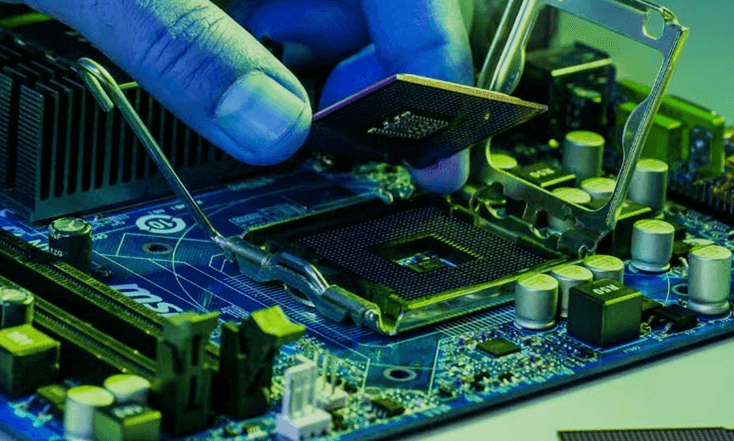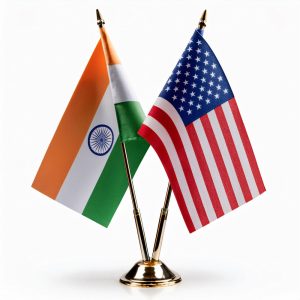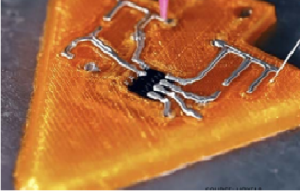INDIA’S AMBITIOUS PATH TO SEMICONDUCTOR REVOLUTION

By Krishaank Jugiani
India’s dream of ‘ushering in a new era in electronics manufacturing’ received an impetus with Prime Minister Narendra Modi’s recent visit to the United States. While ‘Charting a Technology Partnership for Future’, the geopolitically driven Indo-US joint efforts will certainly help India in attracting investments in high-tech manufacturing, particularly in the much talked about semiconductor chips. Micron’s USD 825 million investment in setting up a semiconductor assembly and testing facility in India is an important step forward towards India’s integration into the global semiconductor supply chain.
The semiconductor supply chain is a complex network that spans countries and manufacturers encompassing various stages, including wafer fabrication, assembly, testing, and packaging. Taiwan dominates wafer fabrication, ASML, a Dutch company, maintains a near-monopoly on advanced chip-making machines, while the US excels in design and development and intellectual properties. China dominates the rare earth minerals mining and processing industry while Japan, South Korea, the US, and Europe are major suppliers of specialty chemicals. China and Southeast Asian countries play key roles in assembly, testing, and packaging due to lower labour costs.
However, the pandemic, the US- China trade war and weaponising the supply of chips and related raw materials citing national security, have exposed vulnerabilities in the supply chain. The US, joined by the Netherlands and Japan, has imposed export restrictions on semiconductor- related technologies to China, while China has imposed restrictions on the export of critical minerals – gallium and germanium.
This chip war has caused challenges in the supply chain, including trade flow disruptions, increased costs in dependent industries, and heightened scrutiny of technology transfers. Industries spanning automobiles, consumer electronics like mobile phones, electronic vehicles, high- performance computing and military weapons sectors have all felt the effects and are seeking alternative options.
Efforts are being made to diversify and de-risk the supply chain and enhance domestic manufacturing capabilities in countries like the US, Japan, Australia, India and the European Union. The US, in particular, is promoting ‘friend- shoring’ by partnering with friendly nations to establish production facilities and bolster the supply chain, reduce dependency on a single region, and mitigate geopolitical risks.
Thus, amidst the disruptions caused by the trade war on the back of China’s curtailed dominance, a window of opportunity has arisen for India to strengthen its position in the supply chain. With a target of manufacturing USD 300 billion in electronics by 2026, India is aiming to establish itself in semiconductor manufacturing, leveraging its strategic location in the Indo-Pacific, investment policies, cost-effective production factors and initiatives like “Make in India”.
Capitalising strengths and exploring opportunities
India’s strength in the semiconductor industry lies in chip design, with more than 20,000 design engineers designing about 2,000 chips every year. It benefits from a thriving innovation ecosystem, strong STEM education, and a skilled engineering workforce. The White House’s statement on the U.S.-India Initiative on Critical and Emerging Technology (iCET), highlighting the importance of promoting the development of a skilled workforce and subsequently, Lam Research’s initiative to train 60,000 Indian engineers through its “Semiverse Solution” in India showcases India’s competence in the chip design and presents an opportunity to take a leadership role in the future.
To promote the growth of semiconductor manufacturing, the government launched the ‘Semicon India’ programme with a USD 10 billion investment and fiscal support of up to 50% of the project cost. It aims to establish semiconductor fabs, develop research and development (R&D) capabilities and reduce import dependencies. The ‘India Semiconductor Mission’ (ISM) provides financial support for display manufacturing, encourages indigenous Intellectual Property (IP) generation, and fosters collaborations with national and international agencies.
The Scheme for Promotion of Manufacturing of Electronic Components and Semiconductors (SPECS) incentivises domestic manufacturing of electronic components, offering a 25% financial incentive on capital expenditure. These initiatives collectively aim to foster infrastructure development and innovation to attract investments and promote self-sufficiency in the semiconductor sector, aiming to position India as a global hub for electronics manufacturing.
India is also engaging in silicon diplomacy through international groups like Ǫuad (USA, Australia, Japan, and India). The Ǫuad Semiconductor Supply Chain Initiative, collaborations with Australia and the US through the Australia-India Cyber and Critical Technology Partnership (AICCTP), along with iCET present opportunities for India in technology transfer, skill enhancement, and investment, enabling it to advance in manufacturing and R&D of semiconductors.
However, the US Chips Act, which aims to boost domestic semiconductor production in the US, may present challenges in terms of increased competition for domestic investments. But experts also believe that the Chips Act is aimed to safeguard advanced technologies, and India still has to go a long way in the supply chain. Furthermore, iCET shows US support for the creation of an ecosystem in India for semiconductor design and fabrication. How the two dynamics play out is still to be seen.
Facing the headwinds
India’s ambition to manufacture chips faces several roadblocks. Despite having a sizable proportion of engineers in chip designing, none of the technology is indigenous. The presence of multinational corporations’ R&D labs in India is driven by skilled engineers, while foreign corporations own the intellectual property of chip designs. Most of India’s involvement in the semiconductor industry has been in chip verification. High costs of acquiring IPs, delayed investment returns and dependence on imports for rare earth minerals hinder progress in the industry.
Additionally, competition from established global players, particularly Taiwan, China, and South Korea, and other emerging players like Vietnam and Singapore poses a significant challenge. India’s trade policy, its stand on free trade agreements and its reluctance to sign the WTO’s Information Technology Agreement-2 (ITA-2) may hamper access to foreign investment, technology exports and market access, affecting competitiveness. While its competitors may benefit from increased market access, advanced technological adoption, and global competition.
Paving the way forward
While chip manufacturing is a vital component, it takes time to establish and achieve significant results, due to the capital-intensive nature of the industry. Other areas of the semiconductor industry, such as Assembly, Testing, and Packaging (ATMP) or Outsourced Semiconductor Assembly and Testing (OSAT), are already experiencing significant growth and development as the government’s incentive scheme has attracted interest from companies.
Therefore, it is crucial for India to focus on these areas, capitalising on the existing momentum. It should also focus on manufacturing trailing- edge and large-scale chips for industries such as medical devices and automotive electronics as these chips have significant demand and have less capital-intensive manufacturing requirements compared to leading- edge semiconductors.
Taking advantage of its chip design capabilities, India should prioritise investing in startups and domestic design companies that specialise in designing along with collaborating with leading chip makers. India should also invest in skill development programs to cultivate a skilled workforce. Deloitte estimates that over a million more skilled workers will be needed globally by 2030. With more than 1.5 million engineering students entering the workforce annually, India has the potential to meet this demand.
The Chips-to-Startup (C2S) programme to create over 85,000 skilled manpower by 2027 is a good step in this direction. Nevertheless, collaborative efforts between academia, industry, and training institutes are necessary to develop a talent pool equipped with the necessary skills in chip design, manufacturing, and testing.
India should also reconsider joining ITA-2 for investment, accessing technology, and market competition, strengthening its global trade position. By reducing tariffs and committing to international agreements such as with the EU, India can ensure integration into value chains and ensure a steady supply of minerals and chemicals for the semiconductor industry.
India being a trusted partner for countries like the United States in the present geopolitical scenario can tap into Ǫuad’s expertise to bolster its capabilities – gaining insights into advanced manufacturing and design capabilities from the US, precision engineering and quality control from Japan, and ensuring critical mineral supply from Australia. India may also consider establishing a separate partnership with Australia, apart from AICCTP, specifically dedicated to semiconductor manufacturing. This would enable both countries to leverage each other’s expertise and resources in semiconductor production, creating a mutually beneficial collaboration.
Furthermore, India should also consider collaborating with friendly countries like Kazakhstan as its rare earth mineral resources, strategic location with access to Europe, and government support make it a valuable partner in securing minerals and developing critical mineral exploration capabilities.
In addition, improving the regulatory environment, simplifying bureaucratic procedures, enhancing the ease of doing business, and offering tax incentives will make India an attractive destination for semiconductor companies.
While the ball may have been set rolling with Micron’s investment for setting up a semiconductor assembly and testing facility, India must adopt a proactive approach and concerted efforts in strategies, policies, and investments to carve out a prosperous future in semiconductor manufacturing and also ensure resilience in the global value chain.
About the Author-
Krishaank Jugiani works as a Research Associate with CUTS International – a global policy think tank. His areas of work and interest include telecom policy, cybersecurity and Artificial Intelligence. He is currently working on the Ethical 6G project funded by the Department of Foreign Affairs and Trade, Australian government.




